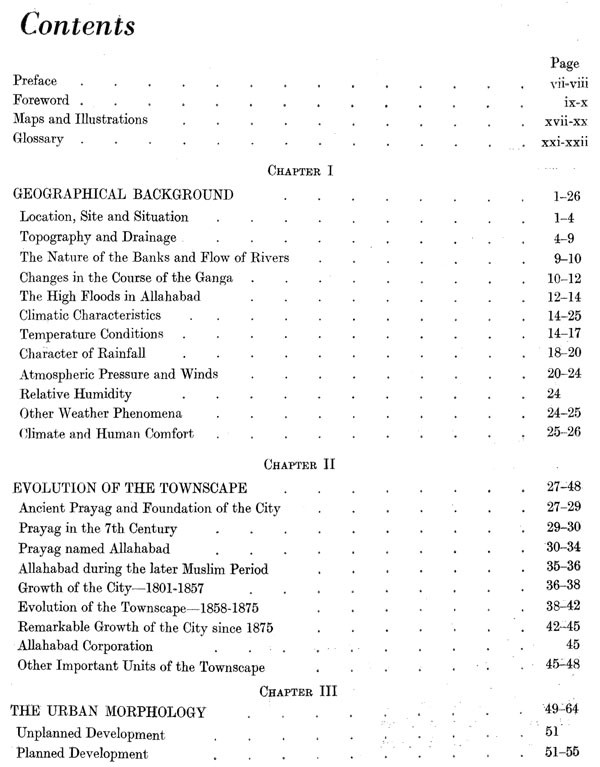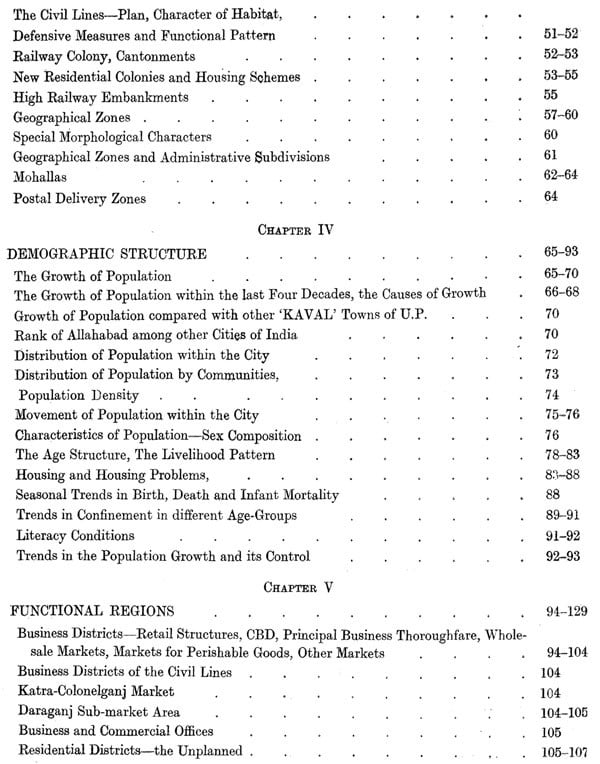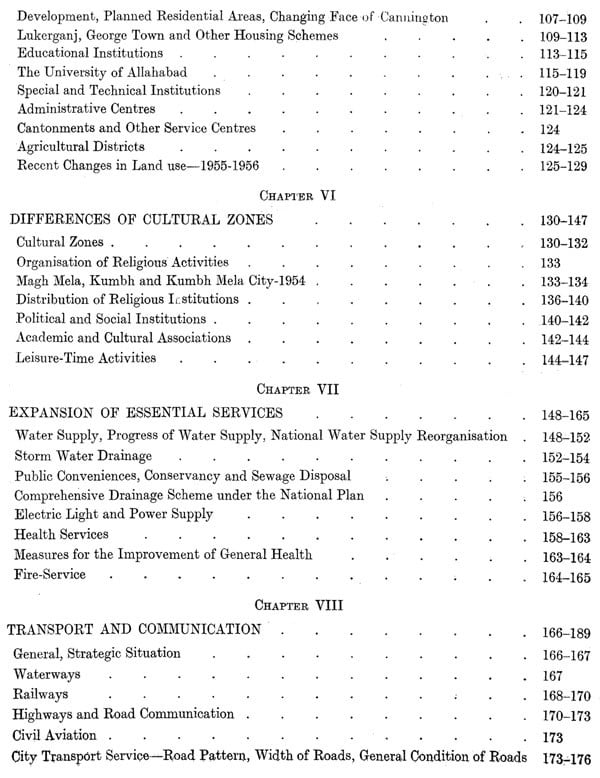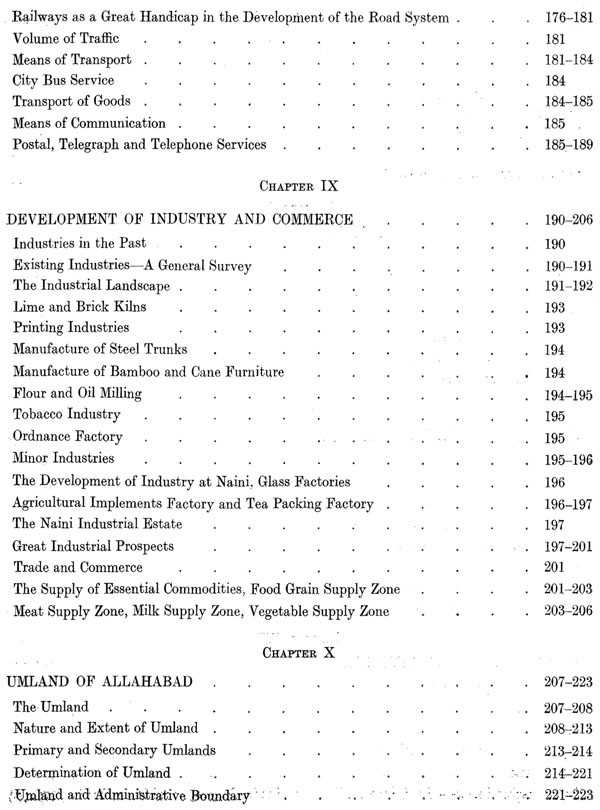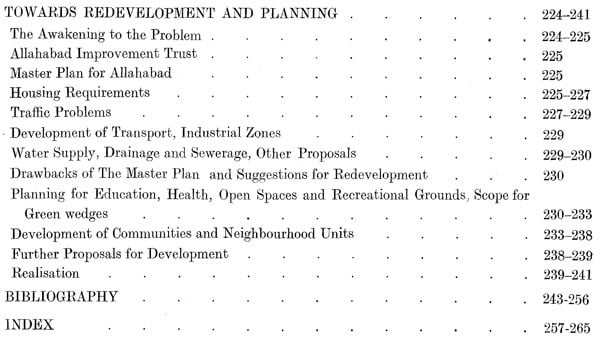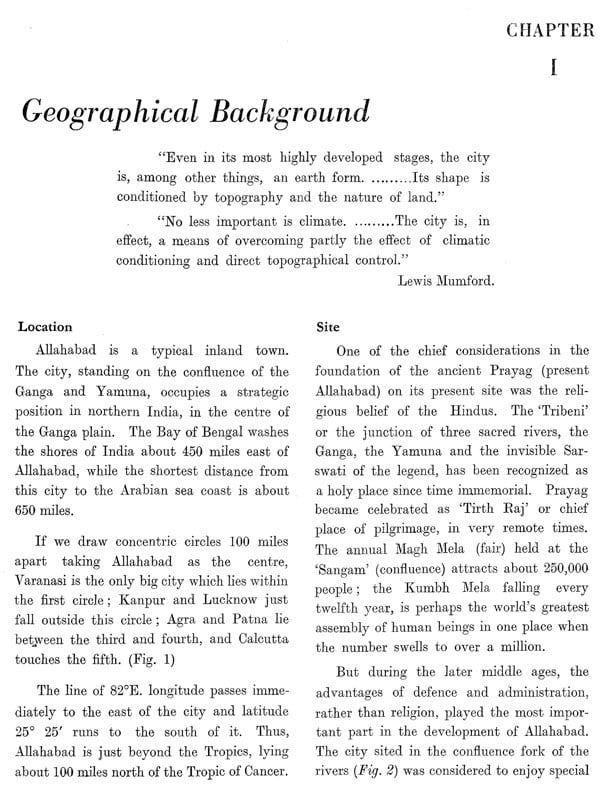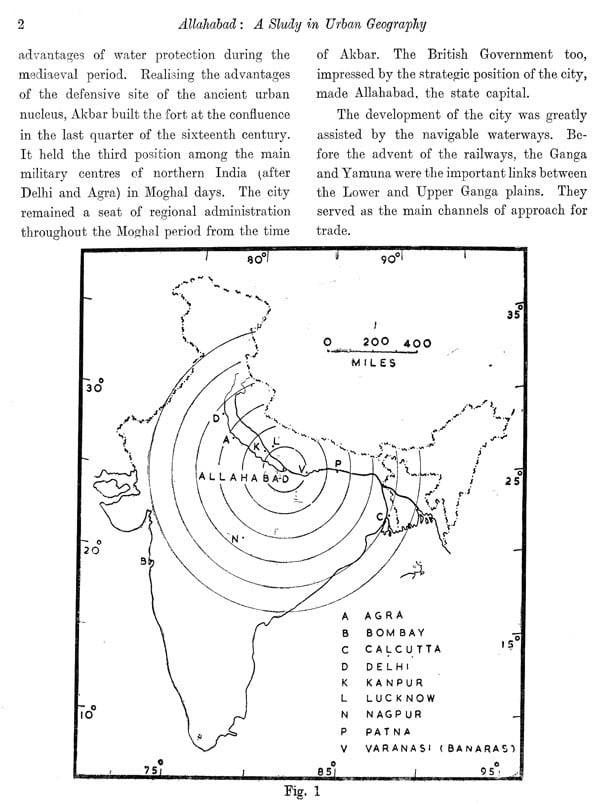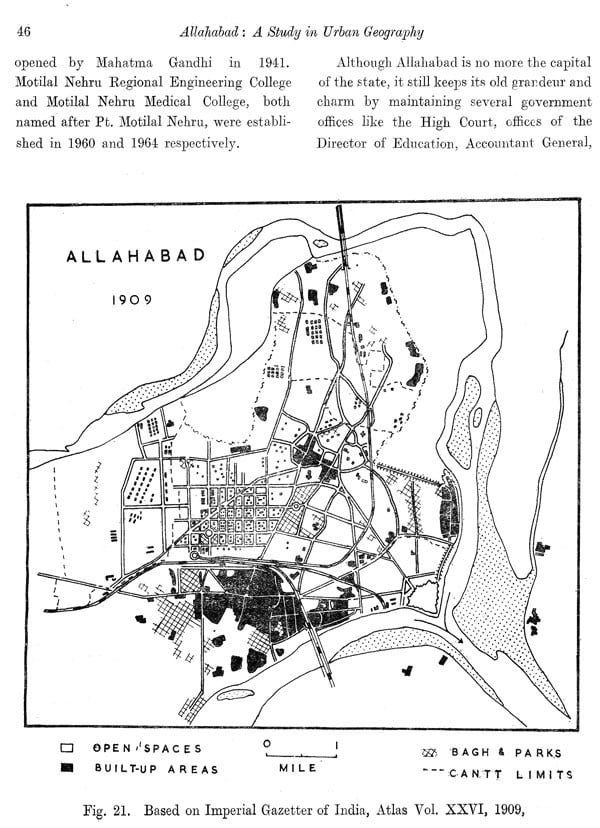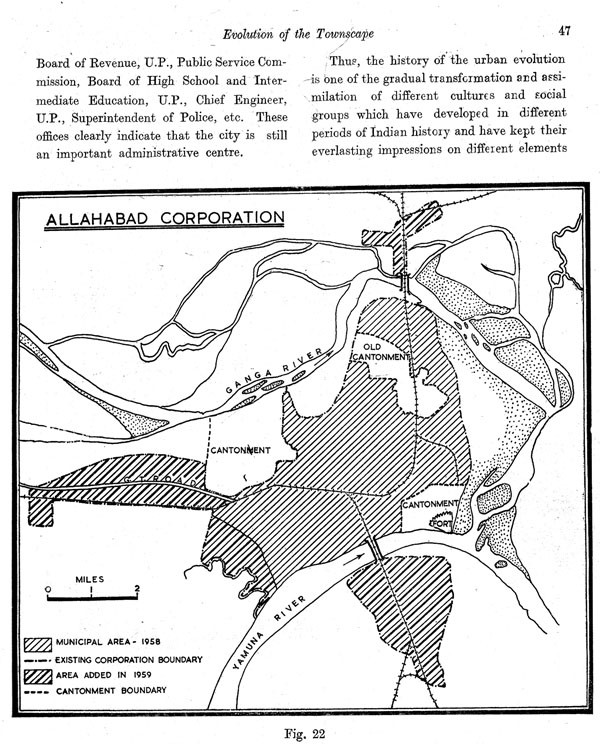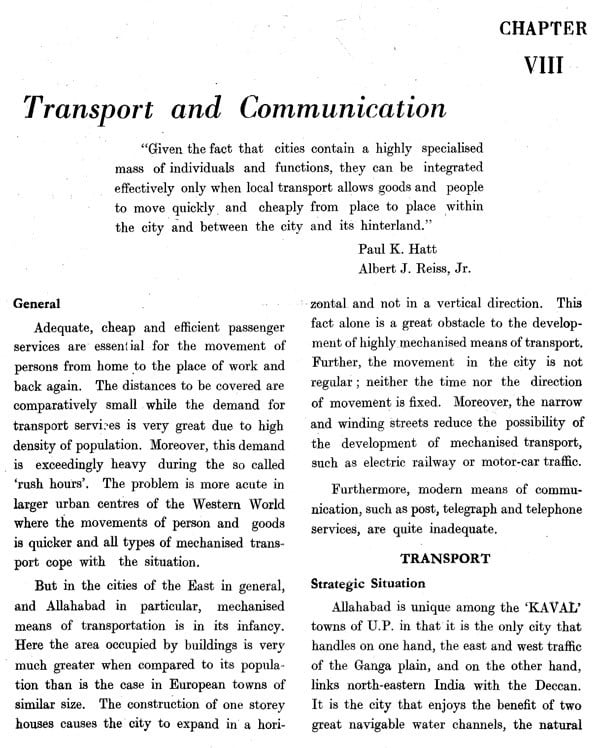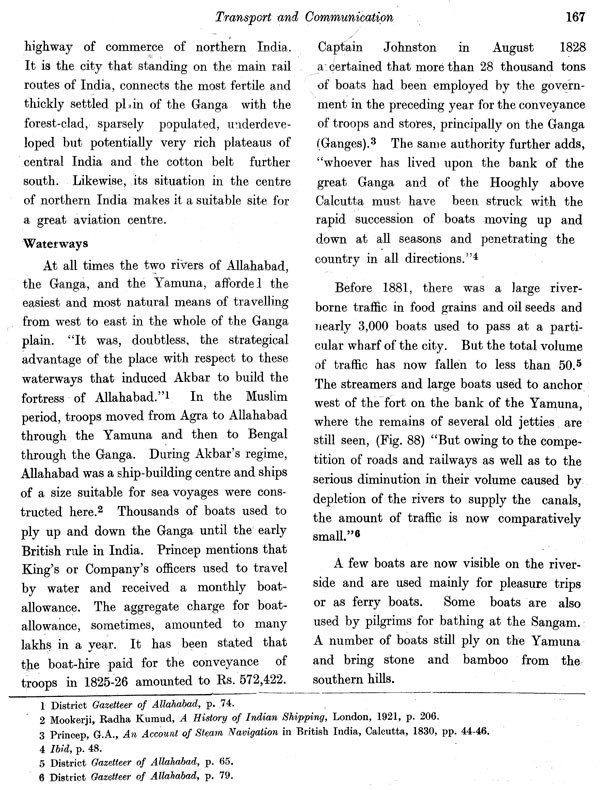
Allahabad- A Study in Urban Geography (An Old and Rare Book)
Book Specification
| Item Code: | NBZ423 |
| Author: | Ujagir Singh |
| Publisher: | Banaras Hindu University |
| Language: | English |
| Edition: | 1966 |
| Pages: | 266 (Throughout B/W Illustrations) |
| Cover: | HARDCOVER |
| Other Details | 10.00 X 7.50 inch |
| Weight | 780 gm |
Book Description
This book is an attempt to study the growth and development of Allahabad City for understanding and interpretation of some of its features with a view to applying the geographer's method of survey and analysis to planning for its orderly growth in future. Allahabad has since time immemorial exercised its influence over a wider area and has passed through many phases in the course of time and is now in a stage of expansion, development and change, rendering this study of immediate and vital significance. The study commences with the discussion of the geographical background that has determined the location of the urban centre on the present site. In the next chapter, the evolution of the townscape has been discussed, with special reference to the foundation and the growth of Allahabad during the Muslim period on the site of the ancient Prayag, and its different phases of development during the British regime, when the town remained the provincial capital for many years. A discussion of the present morphological character forms a part of Chapter III which deals with the geographical zones of the city. Chapter IV deals with the process of the growth and the demographic structure us influenced by the geo-graphical, economic .
and social factors. It is followed by a chapter on the functional regions with special reference to the geographical conditions leading to the segregation of functions into different zones and changes in land-use within the last one decade. Chapter VI, dealing with the differences of cultural zones, supplements the general study of the character of the city. Chapter VII and VIII deal with the expansion of the essential services and the growth of transport and communication as the basis for the cultural and economic development of the city. In Chapter IX, a discussion of the existing industries of Allahabad has been made, and the possibility of industrial development based on the resources of the surrounding area has been analysed.
Chapter X raises the most controversial issue of the determination of the umland. Here an attempt has been made to delimit the umland of Allahabad after examining a number of indices applied for the purpose. Finally in Chapter XI, Master. Plan for Allahabad has been critically examined and an alternative plan for the development of communities is briefly suggested. The whole study is based on the interpretation of a series of detailed original maps and diagrams prepared by the author himself based on the materials collected from different sources during the course of extensive field work.
This work, originally submitted as Ph.D. thesis at the London School of Economics, London University in 1958 and published in a series of papers in different issues of National Geographical Journal of India, is made uptodate by including the latest census records and land-use changes. The author acknowledges with sincere thanks the assistance of several Indian Civil Officers in the preparation of this work, particularly of Mr. G. N. Johri, the Secretary, Improvement Trust, Allahabad, Mr. S. N. Mathur, Executive Engineer (L.S.G.), Allahabad, Mr. J. N. Ghose, Department of Town and Village Planning, U.P., Lucknow, and Mr. K. N. Rao, Department of Climatology and Geophysics, Poona. He is grateful to the members of the staffs of the India Office Library, India House Library, especially to Miss Thorne, Reading Room, and Map Room of the British Museum and the Royal Geographical Society Library, for keeping all available material at his disposal. He would like to express his sincere thanks to Mrs. E. Wilson and Miss S. M. Chantler of the Department of Geography, L. S. E. who took pains in checking the maps and gave valuable suggestions. His thanks are also due to Mr. Shambhoo Pd. and A. K. Karanjai, cartographers in the Department of Geography, Banaras Hindu University for their assistance in drawing a few new maps. The author owes his indebtedness to his friends Mr. W. K. Thomas, a post graduate student in Geography in L.S.E. and Miss N. Blacklock of L.S.E. Library who went through the entire manuscript.
The author is deeply indebted to his supervisor, Prof. L. D. Stamp, from whom he received new inspiration, valuable suggestions and words of encouragemet every time he met him. He is also grateful to him for writing foreword for the book. He is much obliged to Prof. R. L. Singh, Head of the Deptt. of Geography, Banaras Hindu University, for encouragement and aids to this study. His thanks are also due to Dr. S. L. Kayastha, Reader in this Deptt. for his help in correcting the proofs, to Dr. H. H. Singh, Shri Kailash Nath Singh, Sri Bechan Dube and Sri R. P. Singh for their assistance in preparation of Bibliography, Contents and Index. He is also thankful to Sri Lakshmi Das, Manager B.H.U. Press, for taking keen interest in the publication of the book. The author would like to express his obligation to the Banaras Hindu University authorities, specially to Dr. K. N. Lal and the University Grants Commission for financing the publication of the book.
All over the world there are at the present time three trends of major importance. First is the well-known rapid increase in population-at a rate never before known in world history and which must be attributed primarily to the increase in medical knowledge and availability of health services. But second there is the change in the pattern of population distribution. Everywhere there is a movement towards the towns only to be described as a universal urbanization. Already about a hundred of the world's cities have a population exceeding a million, and over the world as a whole four people out of every five now live in towns. Nowhere is this expansion of towns more marked than in India. Forty years ago it was possible to contrast the already huge population of India with the relatively small number of towns with over 100,000 people.
That is no longer true. The third trend is the parallel one of rural depopulation. In all countries the proportion of those living in the country and deriving their livelihood directly from the land is decreasing relatively to total population, in many cases numbers are actually decreasing as food production becomes a mechanized and highly organized business, rather than the result of farming as a way of life. In these changing circumstances it becomes necessary to take a new look at our cities. Fifty years ago geographers were concerned largely with natural regions, tracing the influence of the physical environment on the life of man. To-day the emphasis is changing to the city region for clearly the city has become the dominating influence in the life of its region or umland.
Allahabad is a city which for many centuries has exercised a wide influence it has passed through many phases in the course of time and is now in a vital stage of expansion, development and change. Dr. Ujagir Singh is well aware of these circumstances and has given us this careful study of the city and its region he traces the factors of growth from the distant past to the present and so points to the future. It is inevitable that the application of geographical methods of study and analysis should link with practical planning for the future, rendering this work of immediate and wide significance. I had the advantage of seeing Dr. Singh's work develop from its early stages : I consider the Banaras Hindu University is to be congratulated on its wisdom in publishing the whole completed work.
**Content and Sample Pages**
